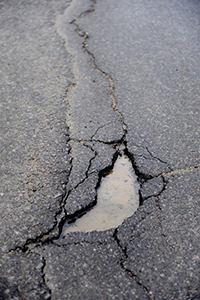 How do you know when its time for parking lot resurfacing? The answer will help inform budgets, planning calendars, and construction timelines. Are there visual cues such as cracks or dips? Or is there a reliable timeframe for standard parking lot resurfacing, such as every 10 years?
How do you know when its time for parking lot resurfacing? The answer will help inform budgets, planning calendars, and construction timelines. Are there visual cues such as cracks or dips? Or is there a reliable timeframe for standard parking lot resurfacing, such as every 10 years?
Simply because a parking lot is showing wear and tear, serious cracking, or standing water does not necessarily mean it needs to be replaced. Resurfacing a parking lot is a great way to boost curb appeal without investing a lot of money.
Over time, asphalt can lose integrity. Therefore, it is important to think about your long-term options for improvement. If 25-35% or more of the total parking lot area is in need of substantial removal due to subgrade or other problems, it is generally more economical, and more effective, to completely reconstruct the parking lot rather than resurfacing.
Not to be confused with seal coating, parking lot resurfacing adds an additional layer of asphalt over the older one. All existing damages to the old pavement such as cracks, soft spots, holes may need to be repaired before the resurfacing. By overlaying new asphalt the lifespan can be extended and older parking lots can be rejuvenated. When done properly, resurfacing your existing asphalt can add an extra 8-15 years out of your current parking lot and costs less than asphalt replacement. However, a newly reconstructed pavement will last anywhere between 20-30 years with proper care and maintenance.
Cracks
Linear cracks (cracks that form nearly straight lines) can be filled with a hot rubberized sealant, or paving fabric can be laid over cracks before resurfacing. Alligator cracks require much more extensive work to fix; if a small area has alligator cracking, it can be fixed prior to resurfacing. If the entire lot has alligator cracking or more extensive damage, complete pavement reconstruction (not just parking lot resurfacing) is probably needed.
Oxidization
When the surface has become heavily oxidized but the base (also known as subgrade) remains in stable condition, resurfacing is a good option. The condition of the subgrade can be tested through core-testing when there is any concern or question of what shape it is in.
Cold Weather Parking Lot Resurfacing
Resurfacing in cold weather leads to cold “seams” which can contribute to premature deterioration and failure. The general rule of thumb is to pave when temperatures are 50° F and rising.
Maintenance
Yearly crack filling and routine sealcoating beginning after the second year will keep your pavement in the best possible condition. In addition, inspecting and cleaning catch basins, retention basins and drains can greatly extend the life of your pavement.
To get started with an estimate for your parking lot paving project, contact Basic Construction at (757) 249-3789, or download our FREE ebook, “Estimating Your Project Right the First Time.”


